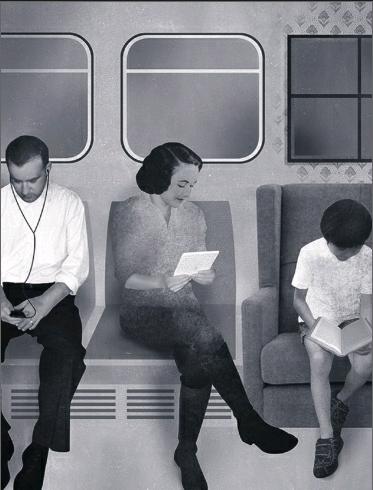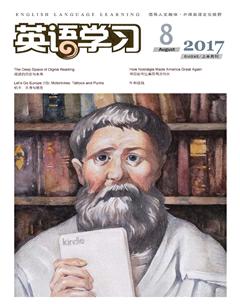閱讀的歷史與未來
By+Paul+La+Farge


In A History of Reading, the Canadian novelist Alberto Manguel describes a remarkable transformation of human consciousness, which took place around the 10th century A.D.: the advent of silent reading. Human beings have been reading for thousands of years, but in antiquity1, the normal thing was to read aloud. When Augustine (the future St. Augustine) went to see his teacher, Ambrose, in Milan, in 384 A.D.,2 he was stunned to see him looking at a book and not saying anything. With the advent of silent reading, Manguel writes,... the reader was at last able to establish an unrestricted relationship with the book and the words. The words no longer needed to occupy the time required to pronounce them. They could exist in interior space, rushing on or barely begun, fully deciphered or only half-said, while the readers thoughts inspected them at leisure, drawing new notions from them, allowing comparisons from memory or from other books left open for simultaneous perusal.3
To read silently is to free your mind to reflect, to remember, to question and compare. The cognitive scientist Maryanne Wolf calls this freedom “the secret gift of time to think”: When the reading brain becomes able to process written symbols automatically, the thinking brain has time to go beyond those symbols, to develop itself and the culture in which it lives.
A thousand years later, critics fear that digital technology has put this gift in peril4. The Internets flood of information, together with the distractions of social media, threaten to overwhelm the interior space of reading, stranding us in what the journalist Nicholas Carr has called “the shallows,” a frenzied flitting from one fact to the next.5 In Carrs view, the “endless, mesmerizing buzz” of the Internet imperils our very being: “One of the greatest dangers we face,” he writes, “as we automate the work of our minds, as we cede control over the flow of our thoughts and memories to a powerful electronic system, is ... a slow erosion of our humanness and our humanity.”6
Theres no question that digital technology presents challenges to the reading brain, but, seen from a historical perspective, these look like differences of degree, rather than of kind. To the extent that digital reading represents something new, its potential cuts both ways7. Done badly, the Internet reduces us to mindless clickers, racing numbly to the bottom of a bottomless feed; but done well, it has the potential to expand and augment8 the very contemplative space that we have prized in ourselves ever since we learned to read without moving our lips.
The fear of technology is not new. In the fifth century B.C., Socrates worried that writing would weaken human memory, and stifle9 judgment. In fact, as Wolf notes in her 2007 book Proust and the Squid: the Story and Science of the Reading Brain, the opposite happened: Faced with the written page, the readers brain develops new capacities. We may not keep the Iliad in our heads any longer, but were exquisitely10 capable of reflecting on it, comparing it to other stories we know, and forming conclusions about human beings ancient and modern.
The Internet may cause our minds to wander off, and yet a quick look at the history of books suggests that we have been wandering off all along. When we read, the eye does not progress steadily along the line of text; it alternates between saccades—little jumps—and brief stops, not unlike the movement of the mouses cursor across a screen of hypertext.11 From the invention of papyrus around 3000 B.C., until about 300 A.D., most written documents were scrolls, which had to be rolled up by one hand as they were unrolled by the other: a truly linear presentation.12 Since then, though, most reading has involved codices, bound books or pamphlets, a major advantage of which (at least compared to the scroll) is that you can jump around in them, from chapter to chapter (the table of contents had been around since roughly the first century B.C.); from text to marginal gloss,13 and, later, to footnote.
In the age of print, nonlinear reading found its most elaborate support in the “book wheel,” invented by the Italian engineer Agostino Ramelli in 1588: a “rotary14 reading desk” which allowed the reader to keep a great number of books at once, and to switch between them by giving the wheel a turn. The book wheel was—unfortunately!—a rarity15 in European libraries, but when you think about all the kinds of reading that print affords, the experience of starting a text at its beginning and reading all the way to the end, which we now associate with “deep” reading, looks less characteristic of print in general than of the novel in particular: the one kind of book in which, we feel, we might be depriving ourselves of something vital if we skipped or skimmed.
The German historian Rolf Engelsing argues that a “reading revolution” took place at the end of the 18th century: Before that point, the typical European reader had only a few books—the Bible, an almanac, maybe a work of devotional literature—and he read them over and over, so that they were deeply impressed on his consciousness.16 Afterward, Europeans read all kinds of material—novels, periodicals, newspapers—and they read each item only once before racing on to the next. Contemporary critics were doubtless appalled, but on the other hand, from that flood of printed matter, we got the Enlightenment, Romanticism, the American and French revolutions.
Its true that studies have found that readers given text on a screen do worse on recall and comprehension tests than readers given the same text on paper. But a 2015 study by the German educator Johannes Naumann suggests the opposite. He gave a group of high-school students the job of tracking down certain pieces of information on websites; he found that the students who regularly did research online—in other words, the ones who expected Web pages to yield17 up useful facts—were better at this task (and at ignoring irrelevant information) than students who used the Internet mostly to send email, chat, and blog.
A new generation of digital writers is building on video games, incorporating their interactive features—and cognitive sparks—into novelistic narratives that embrace the capabilities of our screens and tablets. Samantha Gorman and Danny Cannizzaros 2014 iPad novella, Pry, tells the story of a demolitions expert returned home from the first Gulf War, whose past and present collide, as his vision fails.18 The story is told in text, photographs, video clips, and audio. It uses an interface19 that allows you to follow the action and shift between levels of awareness. As you read text on the screen, describing characters and plot, you draw your fingers apart and see a photograph of the protagonist20, his eyes opening on the world. Pinch your fingers shut and you visit his troubled unconscious;21 words and images race by, as if you are inside his memory. Pry is the opposite of a shallow work; its whole play is between the surface and the depths of the human mind. Reading it is exhilarating22.
在《閱讀的歷史》中,加拿大小說家阿爾維托·曼古埃爾指出了大約公元10世紀時人類意識的偉大轉型:默讀時代的到來。人類讀書的歷史已有上千年,但此前都是朗讀。公元384年,奧古斯丁(即后來的圣奧古斯丁)到米蘭去見他的老師圣安波羅修,當他看到老師默默地看著一本書時嚇了一跳。曼古埃爾寫道,默讀的到來,使讀者終于能夠與書本和文字建立起不受限制的聯系。文字不再念出聲省出了原本所需的時間。它們在自己的空間中既可以一氣呵成,也可以徐徐道來,可以詳盡闡述,也可以留人遐思。而讀者則有充分的時間在閱讀時去審視文字,闡發新的奧義,將其與記憶和手邊同時在研讀的其他書籍做一番參照比較。
默讀解放了你的大腦,使其可以反思,可以記憶,可以提問,可以比較。認知科學家瑪莉安·沃爾夫把這種自由稱作“思考時間的神秘饋贈”:大腦負責閱讀的區域學會自動處理書寫符號之后,負責思考的區域就有時間跳出字面來發展思維和其扎根的文化。
一千年后,評論家們開始擔心數字技術會使這一饋贈面臨風險。互聯網上大量涌現的信息,社交媒體帶來的注意力分散,逐漸侵蝕著閱讀的內在空間,將我們置于記者尼古拉斯·卡爾所說的“淺薄”之中,在一個又一個的事實中狂躁地閃過。在卡爾看來,互聯網“無盡而誘人的嗡鳴”正危及著我們的存在。他寫道:“當我們使大腦自動運轉,并將思想和記憶的掌控權讓渡給強大的電子系統時,我們面臨的巨大的威脅之一就是,作為人的資格和人性的逐漸消蝕。”
無疑,數字技術對閱讀中的大腦來說是一個挑戰,但是從歷史的角度來看,兩者只是程度不同,而非性質有別。數字閱讀帶來了一些新的東西,其結果有利有弊。運用不當的話,互聯網會把我們都變成毫無大腦、只會按鍵的機器,麻木地往下翻著永遠翻不完的頁面;但如果運用得當,互聯網則有可能大大擴展我們自學會默讀以來引以為豪的思維空間。
對技術的恐懼久已有之。公元前五世紀,蘇格拉底擔心書寫會削弱人的記憶,扼殺人的判斷力。而據瑪麗安娜·沃爾夫在《普魯斯特與烏賊:閱讀如何改變我們的思維》中所說,事實恰恰相反:面對書面文字,讀者的大腦發展出了新的能力。我們可能沒法再背誦《伊利亞特》,但是卻可以很好地理解它,跟讀過的其他作品相比較,從而更好地了解人類的古往今來。
互聯網可能會分散人的精力,但是縱觀人類的閱讀史,我們不是一直都在精力分散嗎?閱讀的時候,人眼并非在某一行文字上逐個勻速移動,而是在掃視、跳躍、停頓,與鼠標在屏幕超文本上的移動無異。從公元前三千年左右發明莎草紙開始,到公元三百年為止,多數書寫文獻都是卷軸的形式,讀的時候兩手兼工,一邊要展開,另一邊要收上,是實實在在的線性閱讀。后來,開始有了手抄本、線裝書或者小冊子。這帶來的一個好處是(起碼跟卷軸相比),你可以在書頁間跳躍,從一章跳到另一章(目錄大概是在公元前一世紀左右開始采用的);從文本到旁注,再到腳注。
在印刷時代,非線性閱讀最有力的支持來自“書輪”。它由意大利工程師阿戈斯蒂諾·拉梅利于1588年發明,是一個“旋轉的書桌”,可以讓讀者一次性放好多本書,通過轉動輪子就可以在不同的書之間切換。但非常遺憾的是,書輪是歐洲圖書館才有的珍品,可是想想印刷時代的各種閱讀,把一本書從頭看到尾,即我們現在叫“深度”閱讀的體驗,與其說是印刷帶來的特性,不如說其只是針對小說這個文類。只有小說才會讓我們覺得,如果跳過某一部分或者看得不仔細,就可能會丟掉什么重要的信息。
德國歷史學家羅爾夫·恩格辛指出,18世紀末發生了一場“閱讀革命”:在此之前,一個典型的歐洲讀者擁有的書很少—— 一部《圣經》,一本年歷,或許再加上一本宗教文學——他來來回回地閱讀,把內容深深印在腦海里。后來,歐洲人的閱讀范圍擴大了——小說、雜志、報紙——都只讀一遍就忙不迭地打開另一個。當代評論家對此感到恐慌,但是另一方面,正是這些洪水般的印刷文字,催生了啟蒙運動、浪漫主義、美國獨立戰爭和法國大革命。
確實,研究發現,屏幕閱讀的讀者在進行記憶和理解測試時,表現不如紙上閱讀者。但德國教育學家約翰內斯·諾曼2015年的研究卻得出相反的結論。他讓一組高中生去搜集網頁上的某些特定信息,然后發現經常在網上查找資料的學生——換句話說,那些相信網頁可以產出有用信息的學生——這一任務(包括過濾無用的信息)完成得更好;而只是利用網絡發郵件、聊天、寫博客的學生則差些。
新一代的數字作家正在從電子游戲中尋找靈感,把交互性和認知力融入到通過屏幕閱讀的小說創作中去。薩曼莎·戈爾曼和丹尼·康尼查羅2014年創作的通過iPad閱讀的中篇小說《偷窺》,講述了一個爆破專家在第一次海灣戰爭后回家的故事。主人公逐漸喪失視力之后,過去和現在交織在一起。整個小說通過文本、圖片、視頻和音頻講述。這種界面使人跟隨著故事的進展,在不同的意識層面之間穿梭。你讀著屏幕上描述角色和情節的文字時,兩指劃開,可以看到主角的照片,看到他睜大眼睛望著這個世界。兩指合攏,你則進入了他備受折磨的潛意識;文字和圖像接踵而來,就好像你在他的記憶里一樣。《偷窺》絕不是一部膚淺的作品,其整個故事觸及了人腦的深淺各層,閱讀過程讓人激動異常。
1. antiquity: (尤指公元476年羅馬帝國滅亡前的)古代。
2. Augustine: 奧古斯丁(公元354—430),早期西方基督教的神學家、哲學家,著有《懺悔錄》、《論三位一體》等,其一生深受圣安波羅修的影響;Ambrose: 圣安波羅修(約公元340—397),米蘭主教,4世紀基督教著名的拉丁教父,也是羅馬公教公認的四大教會圣師之一。
3. decipher: 譯釋(難解的古代文字,或難理解的事物);inspect: 檢查,審視;perusal: 精讀,細讀。
4. peril: 巨大的危險。
5. strand: 使擱淺,使處于困境;frenzied:狂熱的,狂亂的;flitting: 掠過,閃過。
6. mesmerizing: 迷人的;imperil: 危及,使陷入危險;cede: 割讓,放棄;erosion: 侵蝕,逐步毀壞。
7. cut both ways: 各有利弊。
8. augment: 提高,增大。
9. stifle: 阻止,壓制。
10. exquisitely: 完美地,卓越地。
11. saccade: 跳閱,掃視;cursor: 光標;hypertext: 超文本。
12. papyrus:(尤指古埃及人制造的)莎草紙;scroll: 長卷紙,卷軸;linear:直線的,線性的。
13. codices: codex的復數形式,(古代典籍的)手抄本;pamphlet: 小冊子;marginal gloss: 邊注,旁注。
14. rotary: 旋轉式的。
15. rarity: 罕見之物。
16. almanac: 年歷,歷書;devotional:宗教禮拜的,祈禱的。
17. yield: 產生,出產。
18. demolition: 爆破;the first Gulf War:第一次海灣戰爭,指1990年8月2日至1991年2月28日期間,以美國為首的多國部隊和伊拉克之間發生的一場局部戰爭;collide: 相撞,碰撞。
19. interface: 接口,界面。
20. protagonist: 主人公,主角。
21. pinch: 捏,夾;unconscious: 潛意識(=subconscious)。
22. exhilarating: 令人極度興奮的。

